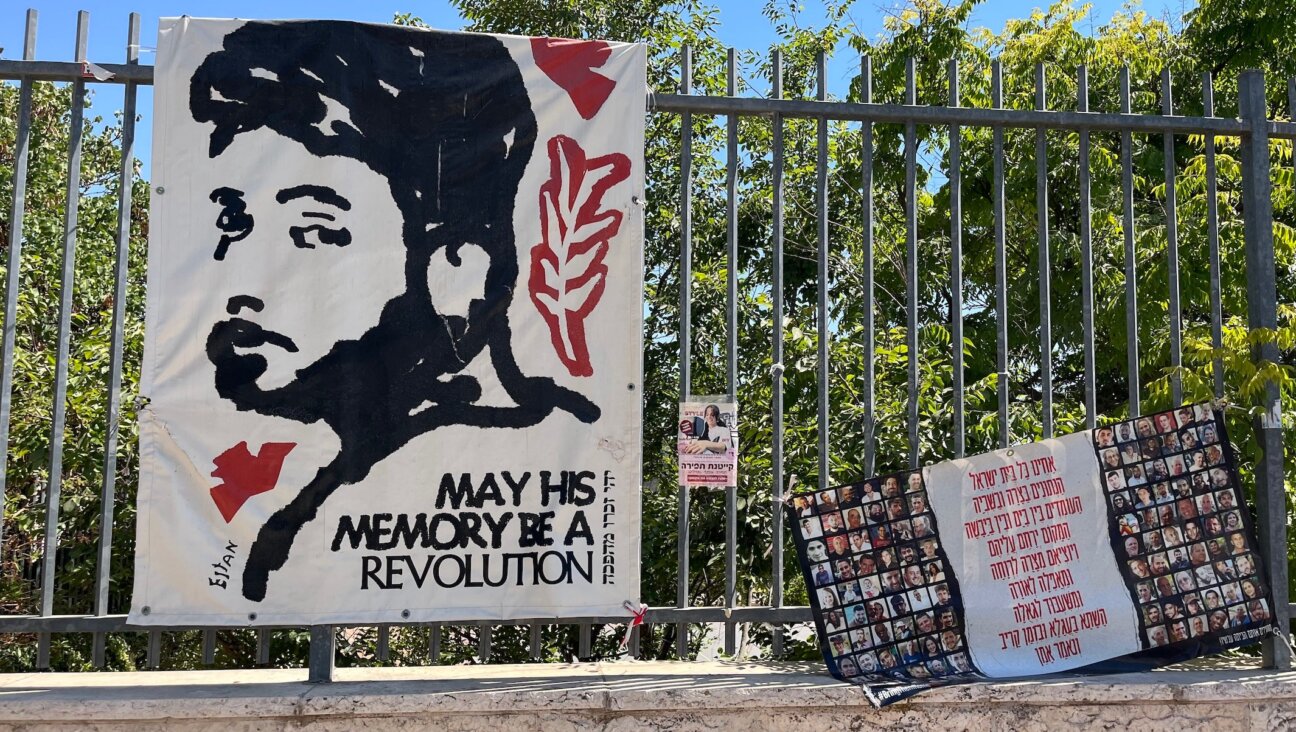Marvin Miller, Led Baseball Players to Free Agency

Graphic by Angelie Zaslavsky

Staunch Unionist: Broadcaster Red Barber called union leader Marvin Miller one of the three most important figures in baseball history, alongside Babe Ruth and Jackie Robinson. Image by wikimedia
The baseball establishment has five times rejected Marvin Miller, who freed players from indentured servitude, from its Hall of Fame.
In a 2008 interview, he said, “After I’m dead, they can induct me and put an asterisk on my plaque, with a footnote: ‘But let’s not forget he was Jewish.’”
It is still questionable whether Miller, in death as in life, can overcome the hostility of baseball’s owners and executives, who considered him a dangerous radical determined to destroy the game they controlled. The baseball moguls may have had nightmares just thinking about what Miller might say about them in his Hall of Fame induction speech.
Miller, who died on November 27 at 95, was never bitter about his exclusion from the Cooperstown shrine. As a staunch unionist, he knew which side he was on. He understood that the baseball owners and executives who control the Hall of Fame would rig the rules to keep him out. The baseball moguls have always viewed their teams as personal fiefdoms and are among the most ferociously anti-union crowd around.
Baseball experts overwhelmingly agree with the great Hall of Fame broadcaster Red Barber, who said that Miller was one of the three most important figures in baseball history, along with Babe Ruth and Jackie Robinson. Even Bud Selig, the former Milwaukee Brewers owner who has been the baseball commissioner since 1998, has said he agrees that Miller belongs in the Hall.
Peter Seitz, the arbitrator who invalidated the reserve clause and created free agency in 1975, called Miller “the Moses who had led baseball’s children of Israel out of the land of bondage.”
So why did Miller fail to receive enough votes each time he was on the ballot?
The major reason is that the selection committees, picked by the Hall of Fame’s board of directors, have been stacked with enough owners and executives, including some with whom Miller tangled as head of the players union, to assure his exclusion.
During the last vote in 2010, for example, Miller received 11 out of 16 votes cast, one less than the 75% needed to gain entry. Although the votes are secret, it is likely that the committee’s four baseball executives — Phillies owner Bill Giles, former Cubs and Orioles executive Andy MacPhail, White Sox owner Jerry Reinsdorf, and Kansas City Royals owner David Glass (former CEO of the virulently anti-union Walmart) — voted against Miller. Veteran Hall of Fame observers believe that the fifth anti-Miller vote was probably Whitey Herzog, a former manager.
Over the years, the Hall of Fame has inducted many second-rate baseball owners and executives who had little impact on the game. Several former baseball commissioners — including Bowie Kuhn, who lost every battle he fought with Miller — have their own plaques in Cooperstown.
In contrast to these midgets, Miller was a giant. Under Miller’s leadership — which included teaching players about labor history and labor law, giving them a sense of their own power, and training them how to outmaneuver the owners during negotiating sessions — the players won a democratic voice in their workplaces and dramatically improved their pay, pensions, and working conditions.
“I loved baseball and I loved a good fight, and in my mind, ballplayers were among the most exploited workers in America,” Miller wrote in his 1991 autobiography, A Whole Different Ball Game.
Miller was born in the Bronx in 1917 and raised in Brooklyn. Like many Jews of his era, he had a rebellious streak. His father, who sold ladies coats, was an Orthodox Jew, but “from a very early age I felt estranged from his beliefs,” Miller recalled in his memoir. At age 10, he quit his four-day-a-week Hebrew school classes, Miller’s first strike. But as he would reveal later in his life, he also had a knack for negotiation and compromise. As his 13th birthday approached, and not wanting to disappoint his favor, he agreed to take instruction with a private tutor three nights a week for six weeks. “This cram course enabled me to learn enough Hebrew to conduct myself creditably at the bar mitzvah ceremony,” Miller wrote.
Miller walked his first picket lines as a youngster in support of a union organizing drive. His mother, who taught elementary school, was a member of the New York City teachers union. Although he was born with a serious injury to his shoulder, Miller became a good athlete, especially in handball and tennis, and was a lifelong baseball fan.
At New York University he earned a degree in economics in 1938. During World War II, he worked for the National War Labor Board, resolving labor-management disputes. After working for the International Association of Machinists and the United Auto Workers, he joined the staff of the United Steelworkers Union in 1950. As the union’s chief economist, and then as an assistant to its president, Miller was knee-deep in contract negotiations.
In 1965, the baseball players association — they resisted using the word “union” — was a toothless tiger. Some players, glad just to be getting paid to put on a uniform, opposed joining a union. The players group had no full-time staff , and its tiny budget depended on donations from baseball teams owners. (It had only $5,400 in the bank). That year, upset by their stingy pension plan, three star players – pitchers Robin Roberts and Jim Bunning, and infielder Harvey Kuenn – decided that the players association needed a skilled leader to help them transform the sport’s outdated labor relations. A friend of Roberts recommended Miller, but to get the job he needed to win the votes of the players, so he visited each team to introduce himself.
Before Miller’s initial meeting with the Yankees, “we were all expecting to see someone with a cigar out of the corner of his mouth, a real knuckle-dragging ‘deze and doze’ guy,” recalled Jim Bouton, the former Yankees pitcher, according to John Helyar in his 1995 book, The Lords of the Realm: The Real History of Baseball. But Miller didn’t fit the stereotype. The players were surprised, when “in walks this quiet, mild, exceedingly understated man,” said Bouton.
But that didn’t mean Miller lacked chutzpah or principles. During his first round of meetings with players, Miller explained: “If at any point the owners start singing my praises, there’s only one thing for you to do, and that’s fire me. And I’m not kidding.”
Miller got the job. The owners, and their hired commissioners, fought Miller at every turn. Like all business leaders, baseball’s owners warned that the union, higher wages and stronger workplace rules would destroy the industry. At the time, most baseball writers sided with management and severely attacked Miller and the union.
Before the union could challenge the owners, however, Miller had to get the players to stand up for themselves. “People today don’t understand how beaten down the players were back then,” Miller told us. “The players had low self-esteem, as any people in their position would have—like baggage owned by the clubs.”
During his 1999 Hall of Fame induction speech, Nolan Ryan reminded listeners that when he broke into the major leagues in 1966, he had to spend the winter months working at a gas station from 3 p.m. to 9 p.m., while his wife worked at a local bookstore, to make ends meet. Because of Miller’s efforts, Ryan said, “we brought that level up to where the players weren’t put in that situation.”
Miller instructed ballplayers in the ABCs of trade unionism: fight for your rights to be treated as more than property, stick together against management, work on behalf of players who came before you and who would come after you, prepare yourself — professionally and financially — for life after your playing days are over, and don’t allow owners to divide players by race, income or their place in the celebrity pecking order.
And like any good union negotiator, Miller helped the players focus on pension issues. Most professional athletes are lucky to have ten-year careers. The average stay in the big leagues for baseball players is 5.6 years, but less for pitchers. So increasing payments and shortening the number of years needed to qualify for a pension became critical issues.
The 1972 baseball strike was primarily about pensions for players. Today, even baseball players who had short and less-than-illustrious careers have good retirement benefits. Duane Kuiper—a second baseman for the Cleveland Indians and San Francisco Giants from 1974 to 1985—told the San Francisco Chronicle, “I don’t think any of us really appreciated Marvin until we all got older.”
Before Miller, players had no rights to determine the conditions of their employment. They were tethered to their teams through the “reserve clause” in every player’s contract. Those contracts were limited to one season. The contracts “reserved” the team’s right to “retain” the player for the next season. Each year, the team owners told players: Take it or leave it.
The players had no leverage to negotiate better deals. Even superstars went hat-in-hand to owners at the end of the season, begging for a raise.
Two years after Miller took the union’s reins, the players association negotiated its first collective bargaining agreement. It established players’ rights to binding arbitration over salaries and grievances.
Players also won the right to have agents to negotiate their contracts. In 1976, they won the right to become free agents. This gave players the right to decide for themselves which employer they wanted to work for, to veto proposed trades, and to bargain for the best contract. The players association also won increased per-diem allowances, improvements in travel conditions and better training facilities, locker room conditions and medical treatment.
“The difference between a ballplayer’s being required to accept whatever a club offered him, as had been the case almost from the beginning of professional baseball, and the new system of salary arbitration was like the difference between dictatorship and democracy,” Miller wrote in his autobiography.
In 1980, the owners sought to regain control over the players by demanding that each team receive compensation for free agents, a move designed to weaken the free agency system. The owners knew that their demand would provoke a players strike, but they figured that they could outlast the players. They miscalculated. The players voted 967 to 1 in favor of a strike. After more than a year of negotiations, the owners refused to budge. So on June 12, 1981, the players walked out. With the Players Association keeping the players informed about the ongoing talks, they stuck together, from superstar outfielder Dave Winfield (who lost roughly $7,770 for each day of the strike) to players earning the minimum salary of $32,5000 (who lost about $180 a day). On August 10, after 50 days and 712 cancelled games, the owners caved in.
“From the standpoint of labor it was the most principled strike I’ve ever been associated with,” recalled Miller, who took himself off the Players Association payroll during the strike to demonstrate his own solidarity. “Many of the players struck not for a better deal for themselves but for a better deal for their colleagues, and for the players who would be coming into baseball in the future…There were veterans on every team who remembered how it used to be and the role of union solidarity in changing things.”
The Major League Baseball Players Association is now the most successful union in the country. In 1967, the minimum salary was $6,000 and the average salary was $19,000. The first collective bargaining agreement the next year raised the minimum to $10,000. By the time Miller retired, the average player salary had increased to $240,000. Today, the minimum salary is $480,000 and the average salary is $3.1 million.
Baseball today is more popular and prosperous than ever. Last year, Major League Baseball had over $6 billion in revenues and 74.8 million in attendance, one of the highest marks on record. Money from television contracts and commercial endorsements have filled the sports’ coffers. Rather than stifle baseball’s prosperity, the union has simply given players the power to win a greater share of their employers’ growing revenues.
Pro athletes in other major team sports—football, basketball and hockey—saw what Miller accomplished and eventually won the same bargaining rights as their baseball compatriots.
No other figure in history comes close to Miller in terms of his role in revolutionizing the American sports business. So the petty baseball moguls, determined to win retribution, have kept him out of their Cooperstown shrine.
In an interview with us, Miller said he wasn’t concerned about getting into the Hall. He was satisfied with his legacy of turning the players union into a powerful force and a model for what a strong labor movement could achieve. After being rejected five times, he said, “I told myself it wasn’t going to happen.”
In 2009, Miller was inducted into the National Jewish Sports Hall of Fame. But simple justice requires that Miller be admitted to the Baseball Hall of Fame in Cooperstown.
If a significant number of Hall of Famers and rank-and-file players join the crusade, it will be difficult for the next selection committee to reject Miller for the sixth time. Every player who donned a major league uniform over the past 40 years owes a huge debt of gratitude to Miller. They can repay it by acting like union members and mobilizing a campaign to pressure the Hall of Fame to end its blacklist of this remarkable labor and sports pioneer.
Peter Dreier, who teaches politics at Occidental College, is the author of The 100 Greatest Americans of the 20th Century: A Social Justice Hall of Fame (Nation Books, 2012) . Kelly Candaele, a Los Angeles writer, produced the documentary film, “A League of Their Own,” about his mother’s years in the All American Girls Professional Baseball League.






















